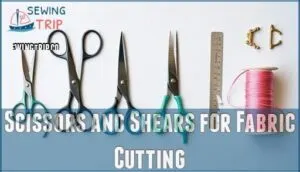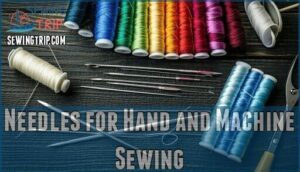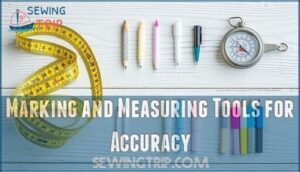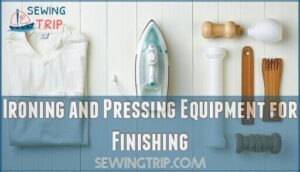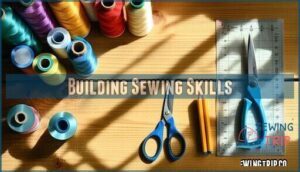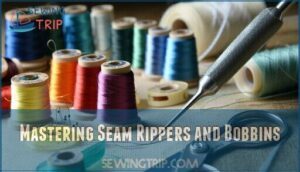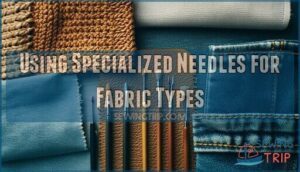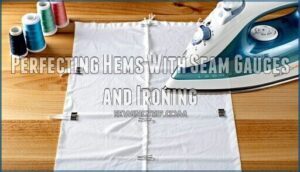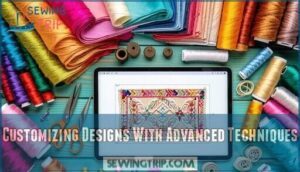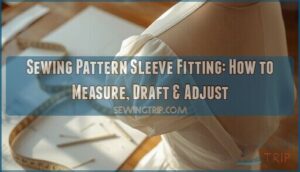This site is supported by our readers. We may earn a commission, at no cost to you, if you purchase through links.
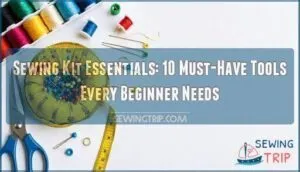 You’ll need these sewing kit essentials to get started: sharp fabric scissors that cut cleanly, a variety of needles for different fabrics, straight pins to hold pieces together, and a measuring tape for accurate sizing.
You’ll need these sewing kit essentials to get started: sharp fabric scissors that cut cleanly, a variety of needles for different fabrics, straight pins to hold pieces together, and a measuring tape for accurate sizing.
Don’t forget thread in basic colors, a seam ripper for fixing mistakes, and a pin cushion to keep everything organized.
Quality scissors make all the difference—they’re like a chef’s knife in the kitchen.
Add a thimble to protect your finger and good lighting to see your work clearly.
These tools form your foundation, but choosing the right needle for each fabric type can make or break your project.
Table Of Contents
- Key Takeaways
- Sewing Kit Basics
- Top 10 Sewing Essentials
- 1. Kai 5230 9 Inch Bent Trimming Scissors
- 2. Heavy Duty Fabric Cutting Scissors
- 3. Aqueenly Gold Stork Embroidery Scissors
- 4. Professional Pinking Shears Fabric Leather
- 5. Singer Multicolor Pearlized Straight Pins
- 6. Large Tomato Strawberry Emery Pin Cushion
- 7. Universal Sewing Machine Needles Set
- 8. Assorted Hand Sewing Needle Set
- 9. Soft Tailor Tape Measure Ruler
- 10. Clover Sliding Gauge Sewing Tool
- Sewing Tools Overview
- Building Sewing Skills
- Advanced Sewing Techniques
- Frequently Asked Questions (FAQs)
- Conclusion
Key Takeaways
- Start with quality basics – You’ll need sharp fabric scissors, measuring tape, pins, needles, and thread in basic colors to handle most beginner projects and repairs effectively.
- Invest in proper cutting tools – Quality scissors, like bent trimming shears and pinking shears, make clean cuts without fraying, while cheap tools create messy edges that scream amateur work.
- Match your needles to your fabric – Universal needles work for most materials, but you’ll get better results using ballpoint needles for knits, denim needles for heavy fabrics, and microtex for delicate materials.
- Build skills gradually with simple projects – Start with basic items, like tote bags and pillowcases, to practice straight seams and hemming before moving to complex alterations and custom designs.
Sewing Kit Basics
Starting your sewing journey requires the right tools to make your projects successful and enjoyable.
You’ll need basic equipment like sharp scissors, measuring tape, pins, needles, and thread to handle most beginner sewing tasks with confidence and accuracy.
Essential Tools for Sewing
Every successful sewing project starts with the right sewing kit essentials. Think of these sewing tools as your creative foundation – without them, you’re building on shaky ground.
Your basic sewing supplies should include:
- Sharp sewing scissors – your fabric-cutting lifeline
- Quality needles – hand and machine varieties
- Measuring tape – precision prevents costly mistakes
- Thread collection – basic colors cover most projects
- Seam ripper – everyone’s mistake-fixing friend
Choose ergonomic tools within your budget for comfortable crafting sessions.
Must-Have Equipment for Beginners
Starting your sewing journey requires the right beginner sewing tools. Your sewing machine becomes your workspace partner—Singer or Brother models work well for new sewers.
Essential scissors and measuring basics create clean, accurate cuts. Consider using a thimble for finger protection while hand-sewing.
| Tool Category | Must-Have Items |
|---|---|
| Cutting Tools | Fabric scissors, rotary cutter |
| Measuring | Tape measure, seam gauge |
| Basics | Machine needles, thread selection |
These sewing kit essentials build your foundation.
Importance of Quality Sewing Tools
Quality sewing tools transform your sewing kit essentials from basic to brilliant.
Sharp scissors cut cleanly while dull ones fray fabric edges. Good needles glide smoothly, but cheap ones break mid-project.
Tool longevity means buying once instead of replacing constantly. Project accuracy improves dramatically with reliable equipment.
Cost-effectiveness comes from investing upfront rather than buying replacements. Tool maintenance keeps everything performing perfectly.
Top 10 Sewing Essentials
You’ll need ten basic tools to start your sewing journey with confidence and success.
These essential items will help you cut fabric accurately, measure precisely, and create clean, professional-looking projects from your very first attempt, leading to overall success.
1. Kai 5230 9 Inch Bent Trimming Scissors

The Kai 5230 bent trimming scissors transform your cutting experience with their thoughtful design.
Their bent handle design keeps fabric flat against your work surface while you cut, eliminating the awkward wrist positions that cause fatigue.
The Kai blade quality delivers clean cuts through multiple fabric layers, from delicate silk to heavy denim.
These cutting tools feature stainless steel construction that resists corrosion and maintains sharpness longer than budget alternatives.
For scissors maintenance, simply wipe clean and store safely.
At $20, they’re indispensable sewing kit essentials for precision work.
2. Heavy Duty Fabric Cutting Scissors
Heavy-duty fabric scissors stand as your cutting powerhouse, designed to slice through thick materials with precision. These robust cutting tools feature ergonomic handles that reduce hand strain during extended projects.
Quality fabric scissors with sharp scissors blade types guarantee clean cuts through denim, canvas, and upholstery materials.
Fabric compatibility varies by blade design:
- Straight blades work best for thick, woven fabrics
- Micro-serrated edges grip slippery materials effectively
- Titanium-coated blades resist adhesive buildup
- Heavy-duty springs provide consistent cutting pressure
- Non-slip grips enhance your cutting technique control
Proper scissors maintenance keeps blades sharp—never cut paper with your fabric shears. These sewing kit essentials belong in every serious sewist’s toolkit.
3. Aqueenly Gold Stork Embroidery Scissors
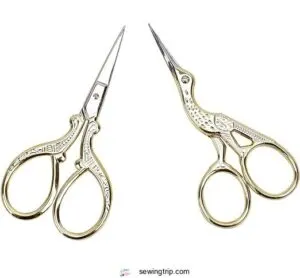
These delicate embroidery scissors pack serious punch for detail work.
The Aqueenly Gold Stork Design features vintage-inspired styling with stainless steel blades that stay sharp through countless projects.
You’ll love how they handle thread cutting and intricate snips around tight corners.
| Feature | Benefit |
|---|---|
| Sharp Blade Benefits | Clean cuts without fraying threads |
| Compact Size | Easy storage in any sewing kit |
| Gold Finish | Durable plating resists tarnishing |
| Stork Handle | Comfortable grip for precision work |
Perfect for Cutting Thread Tips and fine fabric work, these sewing scissors earn their spot among essential sewing kit items for any beginner’s collection.
4. Professional Pinking Shears Fabric Leather
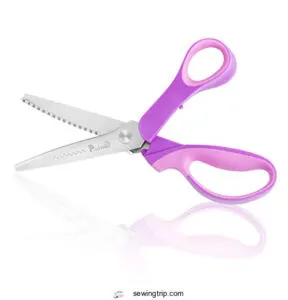
Pinking shears are game-changers in your sewing kit essentials.
These fabric scissors create zig-zag edges that stop fabric fraying in its tracks. They’re perfect for leather cutting and finishing seams without bulk.
Here’s what makes quality pinking shears stand out:
- Stainless steel pinking shear blades that stay sharp longer
- Ergonomic handles with comfortable grip for extended use
- Ball-bearing joints for smooth, effortless cutting action
- 8-9 inch blade length for versatile fabric cutting needs
Practice shear safety by keeping them exclusively for fabric. Regular shear maintenance includes proper storage and occasional blade cleaning. Your fabric cutting will look polished and professional.
5. Singer Multicolor Pearlized Straight Pins
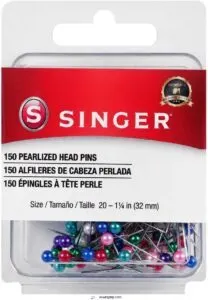
Looking for reliable sewing pins that won’t disappear into your fabric? Singer’s multicolor pearlized straight pins deliver exactly what every beginner needs. These essential tools feature bright, colorful heads that make spotting and retrieving pins effortless during projects.
The nickel-plated construction guarantees rust resistance, while the smooth shafts glide through fabric without snagging. Pin Types like these work perfectly for most sewing kit essentials.
Their sturdy build handles various Pin Materials from cotton to lightweight synthetics. The pearlized heads provide excellent Pin Safety by staying visible against busy patterns.
For Pin Storage, they stack neatly in cushions. These sewing kit musthaves offer beginner-friendly performance at an affordable price point.
Best For: Everyday sewing enthusiasts and crafters looking for affordable and easy-to-use pins.
6. Large Tomato Strawberry Emery Pin Cushion
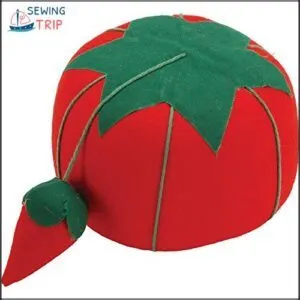
That bright red tomato pincushion with its tiny strawberry companion isn’t just decoration—it’s one of your most reliable sewing kit essentials.
This classic pin cushion keeps your straight pins organized and accessible while you work. The emery-filled strawberry attachment serves a vital purpose: sharpening and cleaning your pins and needles to prevent fabric snags.
Pincushion materials vary from sawdust-filled fabric to magnetic bases, but the traditional tomato design remains popular among sewers. Pincushion styles range from wrist-worn varieties to desktop models.
Pincushion care involves occasional cleaning and refilling when the stuffing compresses.
Pincushion alternatives include magnetic pin holders or foam blocks, but the emery pin cushion combination offers unmatched convenience for maintaining sharp sewing tools.
Best For: Sewers, quilters, and anyone who works with needles and pins and wants a charming and practical way to keep them organized and sharp.
7. Universal Sewing Machine Needles Set
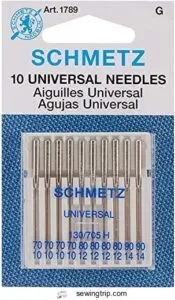
After organizing your pins with that handy tomato cushion, you’ll need the right needles for your sewing machine.
Universal sewing machine needles are your go-to choice for tackling different fabrics without switching needle types constantly. Most needle sets include sizes 70/10, 80/12, and 90/14, giving you options for lightweight cottons to medium-weight denims.
Schmetz and Singer offer reliable needle selection that works with both woven and knit materials. Remember that needle size impacts sharpness, so choose wisely.
Machine compatibility isn’t usually an issue since these needles fit standard home machines. Replace your needle after every project or eight hours of sewing for peak performance.
Best For: All skill levels working with various fabric weights in their sewing kit essentials.
8. Assorted Hand Sewing Needle Set
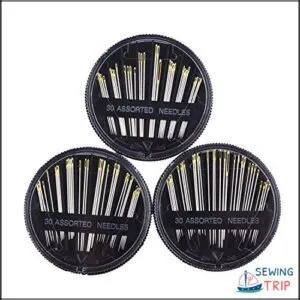
Machine needles handle the heavy lifting, but hand needles are your precision instruments for detail work.
An assorted hand sewing needle set gives you options for every fabric and task. Needle types include sharps for general sewing, embroidery needles for decorative work, and heavy-duty options for thick materials.
Needle sizes range from fine to thick – smaller numbers mean larger needles. Needle selection matters: match your needle to your fabric weight.
Threading needles becomes easier with included threaders. Practice proper needle care by storing them safely and replacing dull ones.
These sewing kit essentials complete your basic toolkit.
9. Soft Tailor Tape Measure Ruler
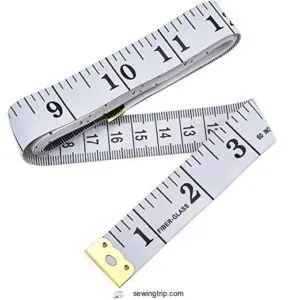
Your soft tailor tape measure becomes your measuring companion for every sewing project.
This flexible ruler handles measuring body dimensions for custom fits and measuring fabric lengths with ease. Choose a dual-sided version showing both inches and centimeters, extending at least 60 inches long for complete coverage.
Tape measure care keeps your tool reliable—store it flat or loosely coiled to prevent stretching. Look for clear markings on durable vinyl material that won’t fade or crack. A retractable design prevents tangled messes in your sewing kit.
Accurate measurements make the difference between perfect fits and frustrating do-overs. From measuring tools in your sewing kit essentials, this tape measure ranks among the most versatile sewing tools you’ll reach for constantly.
10. Clover Sliding Gauge Sewing Tool
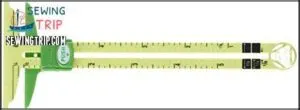
After getting your measurements right with a tape measure, you’ll want pinpoint accuracy for smaller details. The Clover Sliding Gauge delivers exactly that precision you need.
This adjustable tool measures from 0 to 5 inches, perfect for marking buttonholes, seam allowances, and hems. The sliding mechanism locks your measurement in place, ensuring measuring accuracy every time you use it.
Here are the top gauge uses that make it invaluable:
- Buttonhole spacing – Mark consistent distances between buttons
- Seam allowance checking – Verify your seam width stays uniform
- Hem measurements – Create even hems across your entire project
- Pleat marking – Space pleats evenly for professional results
- Scallop patterns – Mark curved edges with precision
Clover gauge benefits include durability and versatility for various sewing projects. While some find it slightly delicate, proper gauge maintenance keeps it functioning smoothly. This tool belongs in every sewing kit checklist alongside your other sewing tools. It’s particularly helpful when working on detailed projects where standard rulers feel too bulky.
Sewing Tools Overview
You’ll find that sewing tools fall into four main groups that work together to create successful projects.
These categories include cutting tools like scissors and shears, needles for both hand and machine work, measuring tools for precise marks and measurements, and pressing equipment to give your finished pieces a professional look.
Scissors and Shears for Fabric Cutting
Sharp scissors and shears form your fabric cutting foundation. Scissors vs shears boils down to size – shears handle heavy-duty fabric cutting with longer blades, while embroidery scissors trim threads precisely.
Pinking shears uses include creating zigzag edges that prevent fraying on lightweight fabrics. Master proper cutting technique by keeping blades perpendicular to fabric.
Rotary cutter blades paired with cutting mats deliver straight, accurate cuts. These essential beginner sewing tools transform messy cuts into professional results. For precision, consider using quality fabric shears.
Needles for Hand and Machine Sewing
Your needle selection makes or breaks every sewing project. Hand needles like sharps work perfectly for most fabrics, while machine needles require specific types—universal for cotton, ballpoint for knits, and heavy-duty for denim.
A good starting point is to buy assorted needle sets for different projects.
Here’s your needle maintenance game plan:
- Match needle sizes to thread weight and fabric thickness
- Replace machine needles every 8-10 hours of sewing time
- Store hand needles in organized cases to prevent dulling
Thread compatibility guarantees smooth stitching every time.
Marking and Measuring Tools for Accuracy
After selecting the right needles, you’ll need reliable measuring tools to guarantee your projects fit perfectly.
Accurate sewing measurements prevent costly mistakes and wasted fabric.
Your measuring toolkit should include these three fundamentals:
- Measuring tape – A flexible tape measure for body measurements and curved seams
- Sewing gauge – A 6-inch ruler with slider for consistent seam allowances and hems
- Fabric marking tools – Tailors chalk options or water-soluble pens for temporary marks
These sewing tools work together to deliver precise measuring technique results every time.
Many retailers offer sewing measuring tape options.
Ironing and Pressing Equipment for Finishing
Every sewing project needs proper ironing and pressing equipment for professional results.
Your iron with adjustable temperature settings paired with a sturdy ironing board creates the foundation.
Press cloth materials protect delicate fabrics from heat damage.
Pressing tools like a tailor’s ham shape curved seams, while sleeve board uses include pressing narrow areas.
For superior performance, consider an iron with a shut-off override.
These ham and roll tools transform amateur work into polished garments worth showing off.
Building Sewing Skills
Once you’ve gathered your essential sewing tools, you’ll need to practice with them to build your skills and confidence.
Start with simple projects like hemming pants or mending small tears, then work your way up to more complex tasks as you become comfortable with your equipment.
Online Tutorials for Beginners
Learning to sew becomes easier when you tap into online tutorials designed for beginners.
YouTube offers thorough sewing basics through channels that break down everything from threading your machine to completing your first project.
These tutorial platforms provide free resources with clear video formats that let you pause, rewind, and practice at your own pace.
- YouTube channels offer step-by-step guidance for your sewing kit for beginners
- Structured courses teach sewing essentials through organized practice exercises
- Free lessons cover project ideas perfect for building confidence
Simple Projects to Start With
Starting with Easy Beginner Projects builds your confidence quickly.
Choose Simple Fabric Choices like cotton for tote bags, pillowcases, and placemats.
These teach Basic Stitching Techniques through straight seams and hemming.
Good Project Planning prevents Common Sewing Mistakes later.
Your sewing kit for beginners handles these perfectly.
Reworking Old Clothes for Practice
Transform your wardrobe with upcycling techniques that breathe new life into forgotten pieces.
That old jacket becomes a trendy vest using your seam ripper from your sewing kit contents.
Practice pattern alterations by shortening sleeves or adjusting hemlines. Your sewing supplies like fabric scissors and measuring tape help execute precise cuts.
Mix textures creatively for design inspiration. Each project builds confidence while reducing waste.
Start with simple alterations before tackling complex project planning – your sewing accessories make it possible.
Using Patterns for Accurate Sizing
Patterns become your roadmap to professional results when you understand sizing fundamentals.
Your measuring tape from your sewing kit contents helps match body measurements to size charts accurately.
Master these pattern essentials:
- Pattern tracing on tissue paper preserves original templates
- Adjusting pattern measurements guarantees proper fit before cutting
- Test fabrics verify sizing before using expensive materials.
Pattern grading transforms store-bought designs into custom-fitted garments.
Advanced Sewing Techniques
Once you’ve mastered basic stitches and seams, you’ll want to expand your skills with more complex sewing methods that require precision and practice.
These advanced techniques use specialized tools from your sewing kit to create professional-looking finishes, perfect fit adjustments, and custom design elements that transform simple projects into polished garments.
Mastering Seam Rippers and Bobbins
Your seam ripper becomes your safety net when stitches go wrong—angle it carefully to avoid fabric damage.
Master Bobbin Winding by checking your machine’s threading path and maintaining proper Bobbin Tension.
Threading Bobbins smoothly prevents tangled messes, while understanding Bobbin Case Issues saves frustration.
These sewing kit components transform mistakes into learning opportunities, making your sewing kit essentials work harder for you.
Using Specialized Needles for Fabric Types
Choosing the right sewing needles transforms your projects from frustrating to flawless.
Needle size selection depends on your fabric’s weight and weave.
- Universal needles: Handle most woven and knit fabrics perfectly
- Ballpoint needles: Knit fabric needles that slip between fibers safely
- Denim needle use: Heavy-duty for thick materials and multiple layers
- Leather needle choice: Wedge-shaped points pierce tough materials cleanly
- Microtex needle benefits: Ultra-sharp points for delicate, tightly-woven fabrics
Selecting the correct needle size based on fabric weight and type is vital for superior results.
Perfecting Hems With Seam Gauges and Ironing
A crooked hem screams amateur work.
Your seam gauge becomes your best friend for consistent hem measurement and gauge placement.
Set the slider to your desired length and mark along fabric edges.
Pressing seams with proper ironing techniques locks everything in place.
Use medium heat and a press cloth for delicate fabrics.
| Fabric Type | Iron Temperature | Press Cloth | Steam Setting | Pressing Time |
|---|---|---|---|---|
| Cotton | High | Optional | Yes | 10-15 seconds |
| Silk | Low | Required | No | 5-8 seconds |
| Wool | Medium | Required | Light steam | 8-12 seconds |
| Polyester | Low-Medium | Optional | Light steam | 6-10 seconds |
| Linen | High | Optional | Yes | 12-18 seconds |
Perfect hem finishes require patience and the right sewing tools.
Customizing Designs With Advanced Techniques
Taking your sewing projects beyond basic stitching transforms ordinary fabric into extraordinary creations.
Your sewing kit becomes a gateway to endless customization possibilities when you master these advanced techniques.
- Appliqué Techniques – Layer fabric pieces for dimensional designs using specialty presser feet
- Pattern Alterations – Modify sewing patterns to fit your unique measurements and style preferences
- Fabric Manipulation – Create texture through pleating, gathering, and strategic cutting methods
- Embellishment Methods – Add beading, embroidery, and decorative stitching for personalized touches
- Design Software – Plan complex sewing projects digitally before cutting fabric
Frequently Asked Questions (FAQs)
What should be in a basic sewing kit?
What’s the foundation of every sewing adventure? You’ll need quality scissors, measuring tape, pins, needles, thread in basic colors, seam ripper, pincushion, and small embroidery scissors for precise work.
What basic sewing equipment do I need?
You’ll need sharp fabric scissors, measuring tape, straight pins, hand-sewing needles, thread in basic colors, seam ripper, pincushion, and an iron. These tools handle most beginner projects and repairs effectively.
What do I need for sewing as a beginner?
Studies show 70% of beginner sewers quit within their first year due to inadequate tools.
You’ll need sharp fabric scissors, measuring tape, pins, needles, thread, seam ripper, and a reliable sewing machine to start successfully.
What to include in a small sewing kit?
Pack sharp fabric scissors, hand-sewing needles, thread in basic colors, straight pins, seam ripper, measuring tape, and small pincushion.
You’ll handle most repairs and simple projects with these compact essentials fitting easily in any travel bag.
What to buy as a beginner in sewing?
Start with a basic sewing machine, fabric scissors, measuring tape, pins, needles, and thread in black and white. Add a seam ripper, iron, and cutting mat for accuracy and efficiency.
What does be in a sewing kit?
Building your first sewing arsenal feels like assembling a toolbox—you’ll need sharp fabric scissors, measuring tape, pins, needles, thread spools, seam ripper, and pincushion to tackle any project confidently.
What type of light is best for sewing?
You’ll need bright, natural daylight or LED lighting for sewing.
Position your lamp to avoid shadows on your work area.
Good lighting prevents eye strain and helps you see fabric details clearly while stitching.
How do I organize my sewing supplies?
Like a well-orchestrated symphony, organize your sewing supplies by grouping similar items together.
Use clear containers for threads, dedicate drawers for tools, and keep frequently used items within arm’s reach for seamless creative flow.
What storage options work for sewing threads?
Thread storage solutions include plastic bobbins for embroidery floss, thread racks for spools, clear containers with compartments, and pegboard systems.
You’ll keep colors organized and prevent tangling while maintaining easy access during projects, which helps in keeping the workspace efficient with easy access.
Are there alternatives to traditional pin cushions?
Yes, you can use magnetic pin holders, wrist pincushions, small bowls, or even a bar of soap.
Magnetic holders work great on metal surfaces, while wrist cushions keep pins handy during detailed work.
Conclusion
Remember, building your sewing kit essentials collection doesn’t happen overnight—but having the right tools transforms your crafting experience from frustrating to fantastic.
Start with quality scissors, reliable needles, and basic measuring tools, then expand your collection as your skills grow.
These ten must-have items create a solid foundation for countless projects ahead.
Whether you’re mending clothes or creating masterpieces, proper sewing kit essentials make every stitch count and every project more enjoyable.
- https://patterns.bootstrapfashion.com/diy-dress-form-sewing-pattern.html?i=6bdd9bee
- https://blog.treasurie.com/measuring-tools-in-sewing-best-tools-list/
- https://seamsecrets.com/hand-sewing-needles/
- https://blog.closetcorepatterns.com/our-pressing-station-the-best-iron-for-serious-sewing
- https://www.wawak.com/garment-finishing-and-packaging-supplies/clothing-press-machine-supplies-and-spot-cleaners/pressing-tools-and-spot-cleaning-products

